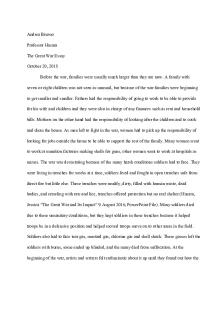Essay \"Discuss the differences between the minority and majority influence\" - grade B- PDF

| Title | Essay \"Discuss the differences between the minority and majority influence\" - grade B- |
|---|---|
| Course | Social Psychology |
| Institution | University of Westminster |
| Pages | 2 |
| File Size | 91.4 KB |
| File Type | |
| Total Downloads | 62 |
| Total Views | 118 |
Summary
Discuss the differences between the minority and majority influence
...
Description
Discuss the differences between the minority and majority influence Majority influence is when the behaviour of a large number of people affects the behaviour of a smaller group of people. Whereas, minority influence is when people have rejected the majority norm (Cook, 2011)
Majority influence Asch (1952) investigated whether people would conform to a majority and give a wrong answer to an unambiguous task. There were 18 trials in total and the confederates gave the wrong answer on 12 trails (critical trials). On average, 37% of the participants conformed with the incorrect majority on the critical trials.
As the size of the group increases, conformity also increases. Groups of 3 or more people are sufficient to cause conformity even when the correct answer is obvious. When the group provide one source of information and are all in mutual agreement, this increases majority influence. Asch repeated his experiment but this time he instructed one of his confederates to give the right answer. He found that conformity rates dropped and the participant was less likely to conform.
There are also cultural differences between majority and minority influence. Members of some collectivist cultures are more likely to be punished or banished if they do not conform, and would therefore be persuaded more by the majority. Whereas in individualistic societies, nonconformity to the majority is common and rarely punished because these cultures emphasize the desirability of individuals being responsible for their own well-being and individual achievement (Bond and Smith, 1993). The type of conformity between majority and minority groups differ. Compliance is more common in majority groups as the individual member changes their outward behaviour to be accepted by the group and avoid rejection, whilst holding different private views. This is because majority influence uses normative influence which occurs when someone conforms in order to gain liking or respect from others.
Minority influence Moscovici (1969) investigated the effects of minority influence on a majority. He placed two confederates amongst four genuine participants. They were shown 36 slides which were different shades of blue and asked to state the colour of each slide. Procedure: In the first condition, the confederates had answered green for each of the 36 slides. In the second part of the experiment, the confederates had answered green 24 times and blue 12 times. Results: in condition one; it was found that the consistent minority had an effect on the majority 8% of the time.
A consistent minority disrupts established norms and creates uncertainty and doubt. This can lead to the majority taking the minority view seriously. Research has shown that if a minority can get the majority to think about arguments for and against, then the minority stands a good chance of influencing the majority (Smith et al, 1996). Mugny et al (1980) argue that influential minorities tend to compromise and show flexibility compared to majority groups. In terms of commitment, internalisation is more common in minority groups. This is when a person conforms because they truly believe the group’s viewpoint.
Conclusion The main differences between majority and minority groups are mainly: type of conformity (e.g. compliance vs. internalisation), culture (collectivistic vs. Individualistic) and norms of that group....
Similar Free PDFs

The Watchmen Essay - Grade: B
- 3 Pages

Discuss Dumbo - Grade: B+
- 1 Pages

The Great War Essay - Grade: B
- 4 Pages

The camp - Grade: B-
- 3 Pages
Popular Institutions
- Tinajero National High School - Annex
- Politeknik Caltex Riau
- Yokohama City University
- SGT University
- University of Al-Qadisiyah
- Divine Word College of Vigan
- Techniek College Rotterdam
- Universidade de Santiago
- Universiti Teknologi MARA Cawangan Johor Kampus Pasir Gudang
- Poltekkes Kemenkes Yogyakarta
- Baguio City National High School
- Colegio san marcos
- preparatoria uno
- Centro de Bachillerato Tecnológico Industrial y de Servicios No. 107
- Dalian Maritime University
- Quang Trung Secondary School
- Colegio Tecnológico en Informática
- Corporación Regional de Educación Superior
- Grupo CEDVA
- Dar Al Uloom University
- Centro de Estudios Preuniversitarios de la Universidad Nacional de Ingeniería
- 上智大学
- Aakash International School, Nuna Majara
- San Felipe Neri Catholic School
- Kang Chiao International School - New Taipei City
- Misamis Occidental National High School
- Institución Educativa Escuela Normal Juan Ladrilleros
- Kolehiyo ng Pantukan
- Batanes State College
- Instituto Continental
- Sekolah Menengah Kejuruan Kesehatan Kaltara (Tarakan)
- Colegio de La Inmaculada Concepcion - Cebu











